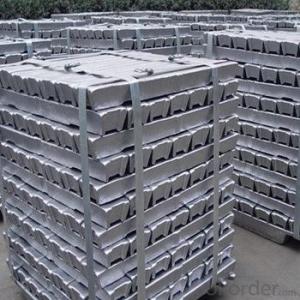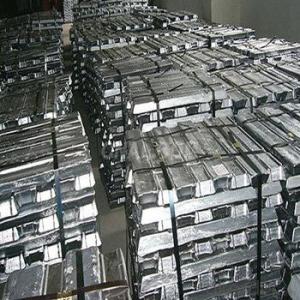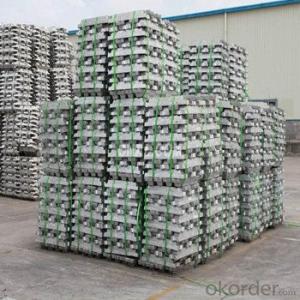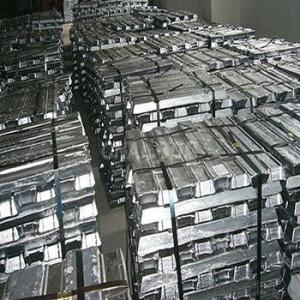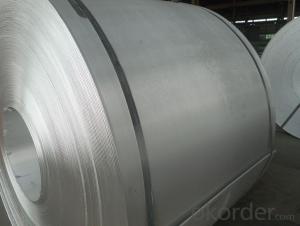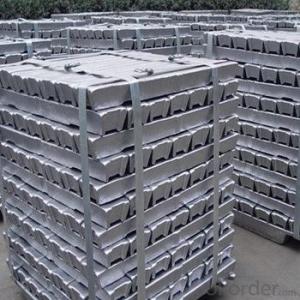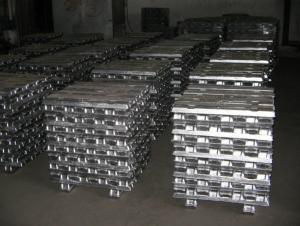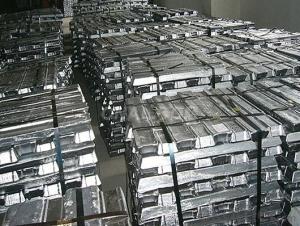Aluminum Pig/Ingot With Mills From China
- Loading Port:
- China main port
- Payment Terms:
- TT OR LC
- Min Order Qty:
- 1000 m.t.
- Supply Capability:
- 100000 m.t./month
OKorder Service Pledge
OKorder Financial Service
You Might Also Like
Pure Aluminum Pig/Ingot Used for Industry
1.Structure of Aluminum Pig/Ingot
A material that has been cast into a shape in order to be transported and processed easier than in an unprocessed form. An ingot is typically rectangular in shape, which allows it to be stacked. Ingots are most commonly associated with metals, with ingots of gold held in the vaults of banks and brokerages being popular images.
Aluminum Ingot is with the AL as the main chemical composition.Aluminum Ingot is used for industry,such as automobile,pinning and weaving,electron broadly and so on. Aluminum Ingot has the following advantages: easy control and operation, fast melting.
2.Main Features of the Aluminum Pig/Ingot
•High Purity
•Easy control and operation
•High strength
•Fast melting
•Competitive price
•Best Service
3.Aluminum Pig/Ingot Images
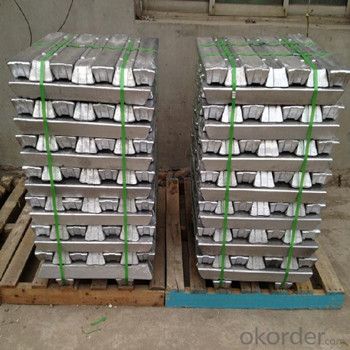
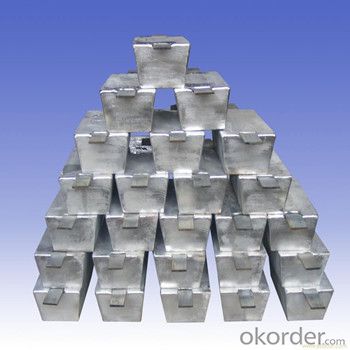
4.Aluminum Pig/Ingot Specification
Grade | Chemical Composition % | |||||||||
Al≥ | impurities ≤ | |||||||||
Si | Fe | Cu | Ga | Mg | Zn | Mn | others | Sum | ||
Al99.9 | 99.90 | 0.50 | 0.07 | 0.005 | 0.02 | 0.01 | 0.025 | - | 0.010 | 0.10 |
Al99.85 | 99.85 | 0.80 | 0.12 | 0.005 | 0.03 | 0.02 | 0.030 | - | 0.015 | 0.15 |
Al99.7 | 99.70 | 0.10 | 0.20 | 0.010 | 0.03 | 0.02 | 0.030 | - | 0.030 | 0.30 |
Al99.6 | 99.60 | 0.16 | 0.25 | 0.010 | 0.03 | 0.03 | 0.030 | - | 0.030 | 0.40 |
Al99.5 | 99.50 | 0.22 | 0.30 | 0.020 | 0.03 | 0.05 | 0.050 | - | 0.030 | 0.50 |
Al99.00 | 99.00 | 0.42 | 0.50 | 0.020 | 0.03 | 0.05 | 0.050 | - | 0.050 | 1.00 |
5.FAQ of Aluminum Pig/Ingot
We have organized several common questions for our clients,may help you sincerely:
①How about your company?
A reliable manufacturer & supplier of Aluminum Pig/Ingot,with many years’ experience in producing Aluminum Pig/Ingot.The items have beedn exported around the world,and have been acceptable among the customers,and have gotten the good reputation already.No matter from the quality,price and service,can be guaranteed for the cusgtomers.High purity and diffent grade are available.
②How to guarantee the quality of the products?
We have established the international advanced quality management system,every link from raw material to final product we have strict quality test;We resolutely put an end to unqualified products flowing into the market. At the same time, we will provide necessary follow-up service assurance.
③How long can we receive the product after purchase?
In the purchase of product within three wo We have organized several common questions for our clients,may help you sincerely:
- Q:How are aluminum ingots melted?
- Aluminum ingots are melted using a process called smelting, which involves heating the ingots in a furnace until they reach their melting point of around 660 degrees Celsius. This heat causes the ingots to liquefy and become molten aluminum, which can then be further processed and used in various industries.
- Q:102 non-standard aluminum ingot is like? And ordinary non-standard aluminum ingot what is the difference?
- 102 refers to ZLD102 bar, since there are grades, that is, GB aluminum ingots. Non-standard 102 may also refer to the main elements in the scope of the impurities exceeded the standard aluminum ingot, non-standard name.
- Q:What are the advantages of using aluminum ingots in electrical applications?
- Using aluminum ingots in electrical applications offers several benefits. To begin with, aluminum's lightweight composition makes it easier to handle and transport, which is particularly advantageous in electrical applications that require consideration of weight, such as power line construction or the manufacturing of electrical appliances. Additionally, aluminum boasts exceptional electrical conductivity, surpassing copper's conductivity by nearly double. This heightened conductivity enables efficient electricity transmission and minimizes energy losses within electrical systems. Furthermore, aluminum ingots possess a remarkable resistance to corrosion. When exposed to air, aluminum develops a protective oxide layer that safeguards against corrosion. Consequently, aluminum proves ideal for outdoor electrical applications that commonly encounter moisture or harsh weather conditions. Moreover, aluminum stands out as an incredibly recyclable material. It can be melted down and reused multiple times without compromising its properties. This not only diminishes the need for new raw materials through mining and extraction but also promotes the sustainability of electrical applications. Lastly, when compared to materials like copper or steel, aluminum ingots prove to be cost-effective. Aluminum is abundant in nature, and its extraction and processing entail relatively lower expenses, making it a more affordable choice for electrical applications. In conclusion, the advantages of utilizing aluminum ingots in electrical applications encompass their lightweight nature, exceptional electrical conductivity, corrosion resistance, recyclability, and cost-effectiveness. These characteristics establish aluminum as a preferred option in various electrical systems, contributing to enhanced efficiency, durability, and environmental sustainability.
- Q:What is the average price of an aluminum ingot?
- The price of an aluminum ingot can fluctuate based on several factors, including market conditions, supply and demand dynamics, and regional influences. As of [current date], the average price stands at around [average price]. Nevertheless, it is crucial to acknowledge that this value is prone to alterations. It is advisable to seek guidance from industry sources or market experts for the latest and most accurate pricing information.
- Q:Difference between ingots and alumina
- Our daily industrial material called aluminum ingots, it is made of alumina cryolite by electrolysis aluminum is produced. The standard containing 99.7% aluminum ingots, registered in the London market is it.
- Q:How are aluminum ingots used in the marine industry?
- Aluminum ingots are extensively used in the marine industry due to their unique properties that make them ideal for various applications. One common use of aluminum ingots in the marine industry is in the construction of boats and ships. Aluminum is chosen for its lightweight nature, which allows for improved fuel efficiency and increased speed. Additionally, aluminum is highly resistant to corrosion, making it an excellent choice for marine environments where exposure to saltwater and harsh weather conditions is common. Aluminum ingots are also used in the manufacturing of marine structures such as docks, piers, and offshore platforms. The durability and strength of aluminum ensure that these structures can withstand the harsh marine environment, including constant exposure to water, waves, and corrosive elements. Furthermore, aluminum ingots are utilized in the production of marine equipment and components. These can include propellers, hulls, masts, and various fittings. The high strength-to-weight ratio of aluminum allows for the production of lighter and more efficient equipment without compromising on durability or performance. In addition to its practical applications, aluminum is also preferred in the marine industry due to its aesthetic appeal. The ability to easily shape and form aluminum allows for the creation of sleek and modern designs that enhance the overall appearance of boats and marine structures. Overall, aluminum ingots play a crucial role in the marine industry by providing lightweight, corrosion-resistant, and durable materials for the construction of boats, ships, marine structures, and equipment. The utilization of aluminum in the marine industry contributes to improved performance, efficiency, and longevity in a challenging marine environment.
- Q:What are the energy requirements for producing aluminum ingots?
- The energy requirements for producing aluminum ingots are significant, as the production process involves several stages that consume large amounts of electricity. The primary energy-intensive steps include mining and refining bauxite ore into alumina, which requires a substantial amount of electrical power. Additionally, the electrolytic reduction of alumina to aluminum in the smelting process demands a significant energy input. Overall, the production of aluminum ingots is an energy-intensive process that necessitates substantial electricity consumption.
- Q:Sincerely ask predecessors to tell me about the processing of aluminum ingots to doors and windows, curtain walls, aluminum profiles, the general process and about the process!
- Then, the aluminum bar is used as the material extruding machine, and then the die is extruded into the shaped section which needs to be shaped. After the cut of the section bar is cut off, the heat treatment is carried out to increase the strength. And then shot peening, oxidation, color, and become our doors and windows, curtain wall materials.
- Q:How are aluminum ingots used in construction?
- Due to their exceptional properties and versatility, aluminum ingots are extensively utilized in the construction industry for various purposes. One of the common applications in construction involves using aluminum ingots to manufacture structural components like beams, columns, and trusses. The lightweight characteristic of aluminum makes it an ideal option for such uses, resulting in cost savings during transportation and installation due to reduced overall weight. Moreover, aluminum ingots are employed in the creation of cladding systems that cover the exterior of buildings. These cladding systems enhance the structure's visual appeal while providing protection against weather conditions and insulation benefits. The corrosion resistance and durability of aluminum make it the preferred material for cladding, enabling it to withstand harsh weather conditions and maintain its appearance over a prolonged period. Additionally, aluminum ingots are utilized in the fabrication of windows, doors, and curtain walls in construction projects. Aluminum frames offer both strength and stability, along with a sleek and modern aesthetic. The material's resistance to corrosion guarantees the longevity and low-maintenance nature of these components. Furthermore, aluminum ingots find applications in roofing systems. Aluminum roofs are highly corrosion-resistant, lightweight, and durable. Additionally, their high reflectivity reduces heat absorption and energy consumption, making them a sustainable choice for building projects. In conclusion, aluminum ingots play a vital role in the construction industry. Their lightweight nature, corrosion resistance, and durability make them an excellent choice for structural components, cladding systems, windows, doors, curtain walls, and roofing systems. The use of aluminum ingots not only enhances the overall aesthetics of a building but also contributes to its longevity, energy efficiency, and sustainability.
- Q:What is the role of aluminum ingots in the production of foils?
- Aluminum ingots play a crucial role in the production of foils. Foils are thin, flexible sheets made primarily from aluminum, which is known for its lightweight, strength, and corrosion-resistant properties. Aluminum ingots serve as the raw material for the manufacturing of foils. The process of producing foils begins with the melting of aluminum ingots. The ingots are heated to a high temperature, causing them to melt and transform into a liquid state. This liquid aluminum is then cast into thin slabs, which are subsequently rolled and reduced in thickness through a series of rolling mills. The aluminum ingots provide the necessary material for this rolling process. They are fed into the rolling mills, where they undergo continuous compression and elongation, transforming them into thin sheets with uniform thickness. The ingots act as the source of aluminum, ensuring a consistent supply of material throughout the rolling process. Aluminum ingots also determine the quality and characteristics of the resulting foils. The composition and purity of the ingots have a direct impact on the final product. High-quality ingots with low levels of impurities result in foils with excellent surface finish, superior strength, and enhanced resistance to corrosion. Furthermore, the size and dimensions of the aluminum ingots influence the size and dimensions of the foils produced. Larger ingots can yield wider and longer foils, while smaller ingots are suitable for narrower and shorter foils. In conclusion, aluminum ingots serve as the starting point and primary material for the production of foils. They are melted, cast, and rolled into thin sheets, providing the necessary aluminum for the manufacturing process. The quality, purity, and size of the ingots directly impact the quality and characteristics of the resulting foils, making them a critical component in the foil production industry.
1. Manufacturer Overview |
|
|---|---|
| Location | |
| Year Established | |
| Annual Output Value | |
| Main Markets | |
| Company Certifications | |
2. Manufacturer Certificates |
|
|---|---|
| a) Certification Name | |
| Range | |
| Reference | |
| Validity Period | |
3. Manufacturer Capability |
|
|---|---|
| a)Trade Capacity | |
| Nearest Port | |
| Export Percentage | |
| No.of Employees in Trade Department | |
| Language Spoken: | |
| b)Factory Information | |
| Factory Size: | |
| No. of Production Lines | |
| Contract Manufacturing | |
| Product Price Range | |
Send your message to us
Aluminum Pig/Ingot With Mills From China
- Loading Port:
- China main port
- Payment Terms:
- TT OR LC
- Min Order Qty:
- 1000 m.t.
- Supply Capability:
- 100000 m.t./month
OKorder Service Pledge
OKorder Financial Service
Similar products
New products
Hot products







